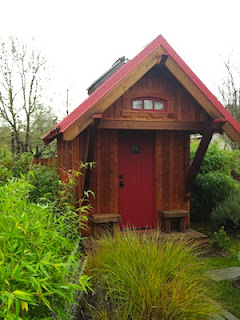Tiny House, Happy Life?
Imagine stepping into a house 25 times smaller than your current abode. For the average American, that would amount to 100 square feet, a space so tiny it feels like it belongs in a tree.
That’s the way Jay Shafer has come home for the past decade. Shafer is considered something of a patriarch of the tiny house movement, a small but growing band of people who drastically shrink their living space in hopes of living a cheaper, less wasteful, and happier life.
Shafer started building tiny houses in the late 90s, attracted to the idea of living with fewer possessions. “When you live in a tiny house you only have room for the things that truly matter,” he told us when we visited his current 106-square-foot home in Sebastopol, California. “You have to choose what’s essential.”
Jay Shafer's 106-square-foot tiny home in Sebastopol, California.
The tour around his house took about three minutes, and with more than one person inside, we had to flatten ourselves against walls or in doorways–actually, doorway, there’s only one–as we moved around. Inside, Shafer has a kitchen sink and stove, a full bathroom with a toilet, shower and sink, plus a living room area that triples as his office and his dining room. And to sleep? There’s a loft with sky lights that a real estate agent might describe as “cozy” or “intimate.” One person in the bed, two max. But no sitting up suddenly.
The movement has picked up momentum over the past few years. A documentary title Tiny showed one man’s process of building a compact house and transitioning to less space. Many tiny homes are off the grid, so no one quite knows how many exist. Several companies, including the one Shafer started, Four Lights Tiny House Company, have begun selling kits to build your own house. The average price tag with materials? About $15,000.
One hundred square feet is small. But with a growing population, and finite space in cities, there’s reason to think the future will be filled with smaller, more efficient homes.
In San Francsico, we caught up with Patrick Kennedy, a developer with Berkeley-based Panoramic Interests to find out what that would mean in a city. Kennedy’s company is developing several Bay Area buildings with “micro” apartment units (“We don’t use the word tiny, micro sounds cooler,” Kennedy says).
At 290 square feet, his units are surprisingly roomy. A Murphy bed doubles as a kitchen table. The breakfast nook turns into a window seat. Otherwise you get a full kitchen, ample storage space and a full sized bathroom. Plus, a rare city find: an in-unit washer and dryer. The price tag? About $950 a month, half the rent of traditional one-bedrooms in the area.
“We’re marketing toward hipsters and service workers,” Kennedy jokes. Qualifying as neither, I could see how the opportunity to cut your apartment and your rent in half could have much wider appeal. If similar developments came to Washington D.C., I’d definitely check them out. And if I happened upon a parcel of land, the prospect of building a small house with my own hands (for under $20,000, to boot) is mighty attractive.
Both Shafer and Kennedy admit it’s not for everyone. But most people come around when they see the space and envision their lives without as much clutter. They also start dreaming about having more money at the end of each month. Although not everyone. One woman admitted to Kennedy that, yes, she could live in a 275-square-foot unit. But she’d have to rent another one for her shoes.
This post is a share from other blog. Click here to see the original link . I believe in "Small things bring big happiness" So Sharing!
That’s the way Jay Shafer has come home for the past decade. Shafer is considered something of a patriarch of the tiny house movement, a small but growing band of people who drastically shrink their living space in hopes of living a cheaper, less wasteful, and happier life.
Shafer started building tiny houses in the late 90s, attracted to the idea of living with fewer possessions. “When you live in a tiny house you only have room for the things that truly matter,” he told us when we visited his current 106-square-foot home in Sebastopol, California. “You have to choose what’s essential.”
 |
Shafer Tiny House |
The tour around his house took about three minutes, and with more than one person inside, we had to flatten ourselves against walls or in doorways–actually, doorway, there’s only one–as we moved around. Inside, Shafer has a kitchen sink and stove, a full bathroom with a toilet, shower and sink, plus a living room area that triples as his office and his dining room. And to sleep? There’s a loft with sky lights that a real estate agent might describe as “cozy” or “intimate.” One person in the bed, two max. But no sitting up suddenly.
The movement has picked up momentum over the past few years. A documentary title Tiny showed one man’s process of building a compact house and transitioning to less space. Many tiny homes are off the grid, so no one quite knows how many exist. Several companies, including the one Shafer started, Four Lights Tiny House Company, have begun selling kits to build your own house. The average price tag with materials? About $15,000.
One hundred square feet is small. But with a growing population, and finite space in cities, there’s reason to think the future will be filled with smaller, more efficient homes.
In San Francsico, we caught up with Patrick Kennedy, a developer with Berkeley-based Panoramic Interests to find out what that would mean in a city. Kennedy’s company is developing several Bay Area buildings with “micro” apartment units (“We don’t use the word tiny, micro sounds cooler,” Kennedy says).
At 290 square feet, his units are surprisingly roomy. A Murphy bed doubles as a kitchen table. The breakfast nook turns into a window seat. Otherwise you get a full kitchen, ample storage space and a full sized bathroom. Plus, a rare city find: an in-unit washer and dryer. The price tag? About $950 a month, half the rent of traditional one-bedrooms in the area.
“We’re marketing toward hipsters and service workers,” Kennedy jokes. Qualifying as neither, I could see how the opportunity to cut your apartment and your rent in half could have much wider appeal. If similar developments came to Washington D.C., I’d definitely check them out. And if I happened upon a parcel of land, the prospect of building a small house with my own hands (for under $20,000, to boot) is mighty attractive.
Both Shafer and Kennedy admit it’s not for everyone. But most people come around when they see the space and envision their lives without as much clutter. They also start dreaming about having more money at the end of each month. Although not everyone. One woman admitted to Kennedy that, yes, she could live in a 275-square-foot unit. But she’d have to rent another one for her shoes.
This post is a share from other blog. Click here to see the original link . I believe in "Small things bring big happiness" So Sharing!



Comments
Post a Comment